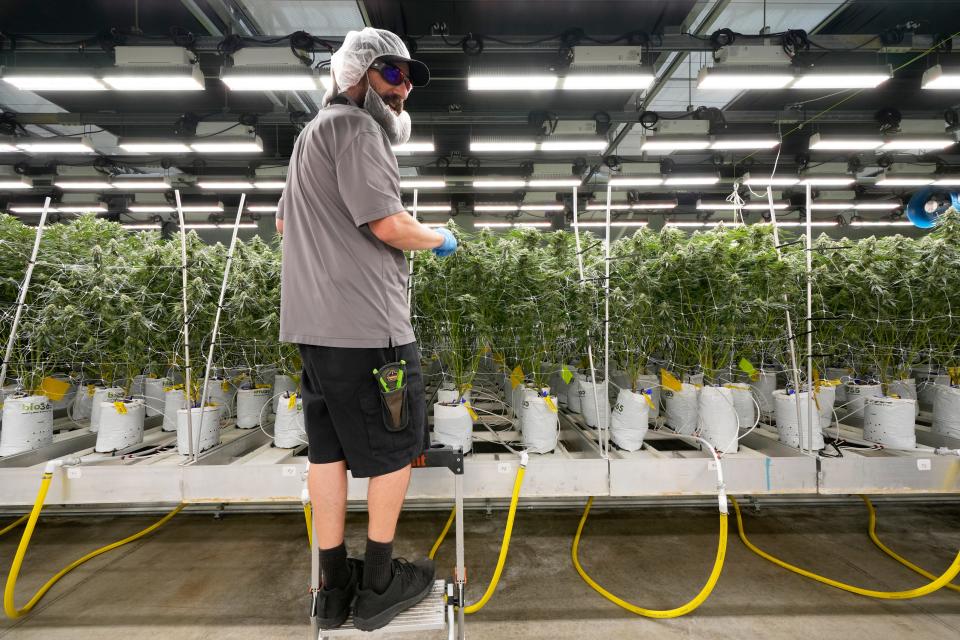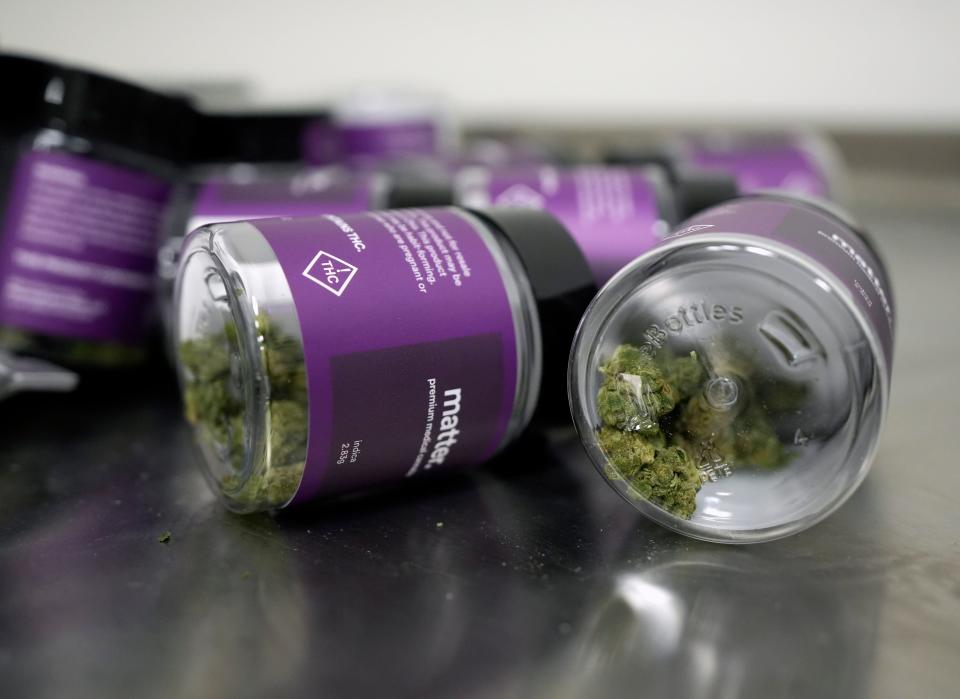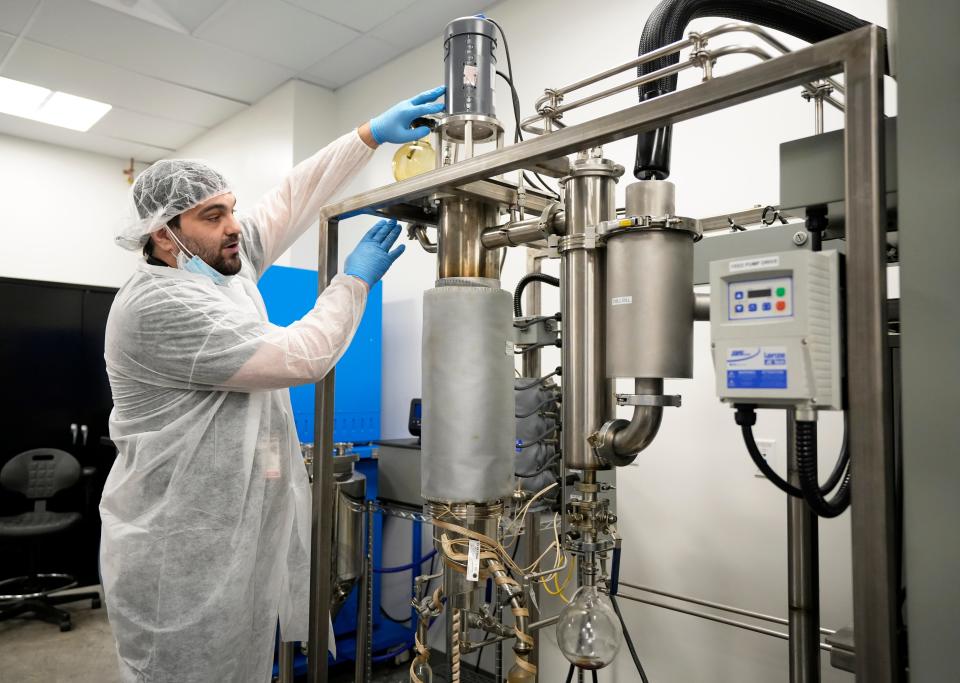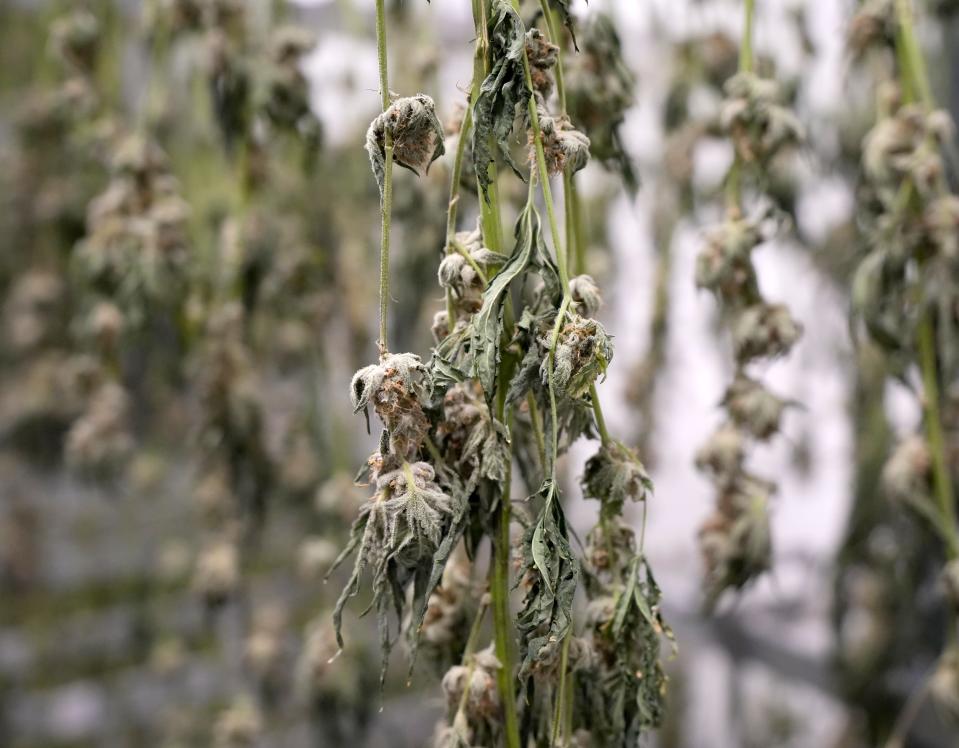Does Ohio have too much marijuana? Medical cannabis industry wary of growth as demand lags
Inside a large, pristine facility at Buckeye Lake, PharmaCann is growing just under 25,000 square feet of marijuana − almost half the size of a football field.
Rooms are filled with nearly 4,500 cannabis plants at different stages that will eventually be sold as flower or processed into edibles or vapes. And PharmaCann could go bigger, if it wanted. Under its license with the state, the company is allowed to cultivate up to 50,000 square feet at the central Ohio facility.
But PharmaCann officials say the numbers don't add up. They believe there's too much supply and not enough demand from patients, many of whom skip the bureaucracy and drive to Michigan for cheaper marijuana. Growing any more in the current market wouldn't work for the company's bottom line, said Jeremy Unruh, vice president of public and regulatory affairs.

"When you’re growing at a loss, you’re producing at a loss in an over-saturated market, your ability to do anything but put out your cheapest product is constrained," Unruh said.
Lawmakers introduced legislation earlier this year aimed at overhauling the program and curing headaches for both patients and businesses. But industry leaders say provisions in the bill that would increase cultivation space could make matters worse.
And a potential November ballot question to legalize recreational marijuana in Ohio may change the equation altogether.

How much marijuana does Ohio have?
Ohio legalized medical marijuana in 2016. Product supply has naturally increased since then as the program matured and more growers came online.
As of June, there were more than 14,500 pounds of plant material available for sale to patients or distribution to a dispensary, according to the Ohio Department of Commerce, which regulates growers. That's a 125% increase from just last year and a 256% jump from the same time in 2021.
That doesn't include thousands of units of other products available in the form of edibles, tinctures, capsules and vape oil. Roughly 560,000 units of edibles were accounted for last month, compared to nearly 301,000 in June 2021.

Patient registrations, meanwhile, have steadily increased over the years, according to the Ohio Board of Pharmacy. But the number of registered Ohioans with an active recommendation from a doctor, allowing them to buy medical marijuana, is dipping. In May, the most recent numbers available, roughly 47% of registered patients had an active recommendation. That figure was nearly 53% in May 2022.
The price of medical marijuana is decreasing as more supply enters the market. Plant sales are currently averaging $18.04 per one-tenth of an ounce, compared to $31.56 in July 2021. (Ohio is the only state to set product limits using tenths, which equals 2.83 grams.)
That average includes discounts, so patients may see a higher sticker price at dispensaries.
Indeed, patients and their advocates say products still cost too much, especially when they can get marijuana at half the cost in neighboring Michigan. On top of that, patients must spend money to visit doctors and keep their registration active.
“Michigan has got it cheaper than we do," said Lorrie Callahan, a patient who lives near Dayton. "That’s part of what’s driven the numbers down in the patient community ... they’re taking that giant risk and crossing state lines."
Bill would expand patient population for medical marijuana
Senate Bill 9 aims to address the problem in part by expanding the number of qualifying conditions for the medical marijuana program. Separately, the Ohio Medical Board added irritable bowel syndrome to the list on Wednesday, a move that will open up access to cannabis for thousands of Ohioans.
Marijuana businesses back such efforts to increase demand, but they're worried about part of Senate Bill 9 that would increase cultivation areas for both large, level I growers and smaller, level II cultivators. The bill would also grant cultivation licenses to stand-alone processors that apply for one.
Cultivators are only using 40% of the available grow space in Ohio, according to March data from the Department of Commerce. Industry leaders say adding to that would create an oversupply of cannabis, similar to what states like Oregon have seen since their programs launched.

While prices would drop more in that scenario, critics of Senate Bill 9 contend it would ultimately hurt patients and limit product availability.
"Operators will streamline production to only the most popular products," said Charlie Trefny, government affairs director for the Ohio Medical Cannabis Industry Association. "Patients relying on highly medical products ... may find it increasingly difficult to access them. Some manufacturers have already cut production lines and cultivators have shut down some of their grow rooms to slow production and reduce overhead."
Sen. Steve Huffman, R-Tipp City, one of the bill's sponsors, doesn't buy concerns about oversupply. He believes the state's biggest marijuana producers are trying to control the market and don't want level II cultivators to have more grow space. That debate has "dragged down" the legislation, Huffman said.
The bill has stalled for now, but Huffman and his co-sponsor, Sen. Kirk Schuring, R-Canton, hope to revive a new version of it in the fall.
Legal recreational marijuana could change the game
Huffman also noted that Ohio cannabis companies are supporting efforts to legalize adult-use marijuana this November. Riviera Creek, Standard Wellness and the owners of Klutch Cannabis − some of the biggest players in the industry − have donated tens of thousands of dollars to the Coalition to Regulate Marijuana Like Alcohol.
If the proposed law passes in November, companies currently licensed for medical would get adult-use licenses. Coalition spokesman Tom Haren, an attorney who represents several cannabis companies, said that's designed to ensure the recreational market gets going right away − not to create a monopoly among current businesses.
The proposed law also creates 40 cultivation licenses for Ohioans who have been disproportionately affected by current marijuana enforcement. And Haren said he expects the state to issue more licenses down the road.

“The idea behind this proposal is we’ll have the right number of licenses when you account for demand in the market," Haren said. "This needs to be a functional market. We don’t want to be like a state out west that has an oversupply."
It's not clear if adult-use marijuana would automatically cure the state's supply woes. Industry leaders say demand typically increases tenfold when a state moves from medical to recreational, but they're also entirely different markets.
Ohio Cannabis Company co-owner Brian Wingfield, who runs multiple dispensaries in the state, believes the market will ping-pong between oversupply and undersupply if Ohio greenlights adult recreational use. Ultimately, he said, growers are taking their best guess about the industry's future when they decide how much to plant.
“If they can figure out how to perfectly plant for the industry as a whole," Wingfield said, "that’s fortune telling."
Haley BeMiller is a reporter for the USA TODAY Network Ohio Bureau, which serves the Columbus Dispatch, Cincinnati Enquirer, Akron Beacon Journal and 18 other affiliated news organizations across Ohio.
Get more political analysis by listening to the Ohio Politics Explained podcast
This article originally appeared on The Columbus Dispatch: Ohio medical marijuana: Industry says supply exceeds patient demand

